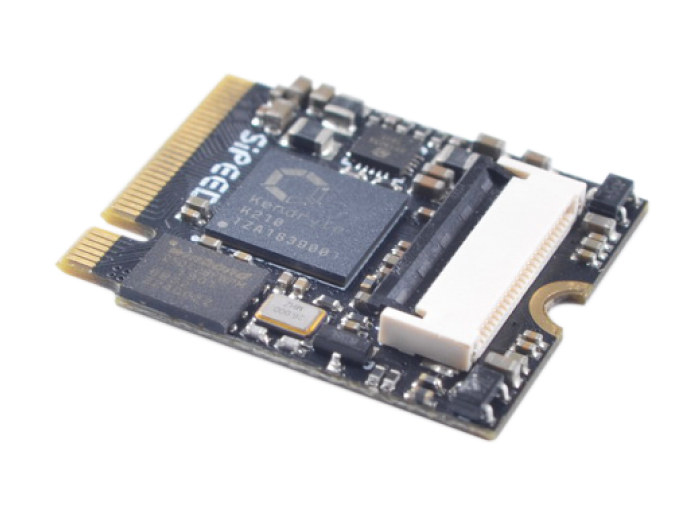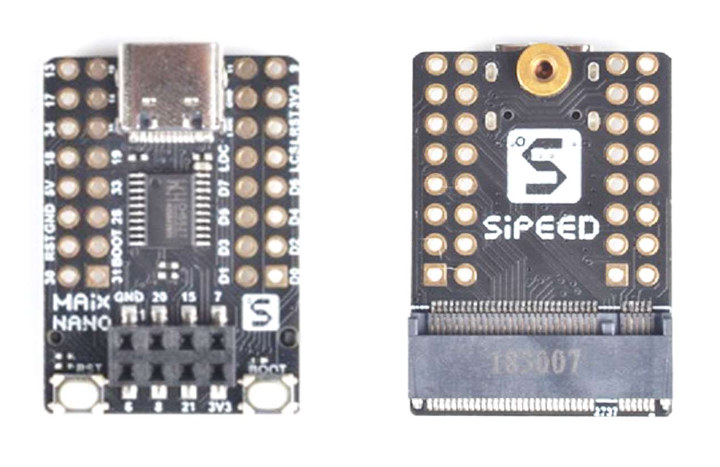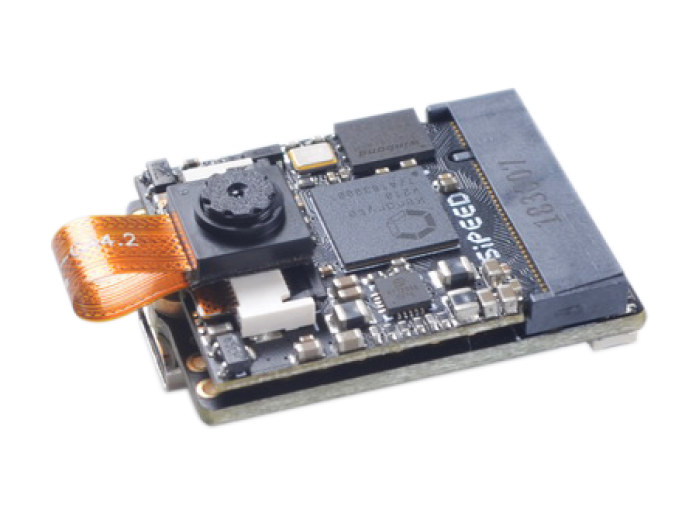Kendryte K210 is a RISC-V processor with AI accelerator found in boards such as Maixduino, Grove AI HAT, or HuskyLens among others, and enabling low-cost, low power AI applications such as face detection or object recognition.
You can now add Kendryte K210 AI accelerator to any board or computer with M.2 socket or [Update: the M.2 connector pinout is non-standard] a USB-C port thanks to Sipeed M1n M.2 module that also comes with an M.2 to USB-C adapter. Sipeed M1n specifications:
Sipeed M1n specifications:
- SoC – Kendryte K210 dual-core 64-bit RISC-V processor @ up to 400MHz with FPU, Neural-network Processing Unit (NPU), audio processor, built-in 6MB SRAM memory for CPU, and 2MB AI SRAM
- Storage – 128Mbit SPI flash
- Camera – 24-pin connector for DVP camera (OV0328 camera module provided as part of the kit)
- Host Interface – M.2 socket with some IOs and JTAG interface, accessible via Maix Nano M.2 to USB-C adapter.
- Supply voltage – 5.0V±0.2V with at least 300mA
- Temperature Range – -30°C – 85 °C

Just like other K210 hardware platforms, it supports image recognition at QVGA resolution up to 60FPS, and VGA resolution up to 30FPS. The company also mentions it supports microphone arrays of up to 8 microphones, but I’m not sure how you would connect those microphones. MAIX Nano M.2 to USB-C adapter comes with 2.54mm pitch through-hole pins exposing LCD signals and 16 GPIO pins, as well as an 8-pin female header. The board support Tensorflow/Keras/Darknet deep learning framework, and can be programmed using MicroPython or Arduino as we explained in our Sipeed M1 getting started guide.
 Sipeed M1n M.2 card ships with a camera and MAIX Nano adapter as pictured above. You’ll find it for pre-order for $9.90 on Seeed Studio with shipping scheduled for March 9th, 2020. Alternatively, you’ll also find the M.2 card on Aliexpress for $10.33 (card only) or $14.09 with the camera and MAIX Nano. This may end up cheaper as shipping is included.
Sipeed M1n M.2 card ships with a camera and MAIX Nano adapter as pictured above. You’ll find it for pre-order for $9.90 on Seeed Studio with shipping scheduled for March 9th, 2020. Alternatively, you’ll also find the M.2 card on Aliexpress for $10.33 (card only) or $14.09 with the camera and MAIX Nano. This may end up cheaper as shipping is included.
The datasheets for the M.2 card and adapter board, as well as documentation for MaixPy IDE for Python programming, can be found in the Documentation tab of the aforelinked page on Seeed Studio.

Jean-Luc started CNX Software in 2010 as a part-time endeavor, before quitting his job as a software engineering manager, and starting to write daily news, and reviews full time later in 2011.
Support CNX Software! Donate via cryptocurrencies, become a Patron on Patreon, or purchase goods on Amazon or Aliexpress




probably the cheapest deepNN HW acceleration with native 2mp camera support
> any board or computer with M.2 socket
I don’t think this would work in an M.2 socket, it’s just using the physical connector from the M.2 spec as a cheaply available form factor. But it doesn’t look like the pinout would work at all if plugged into an M.2 socket instead of its specialized carrier board.
Looking at the schematics and some random M.2 B-key pinout from the internet, I don’t think even the power and ground pins match those of an M.2 socket. It expects 5V input where the M.2 provides 3.3V, expects GND where M.2 is N/A, and the module has I/O and even a 3.3V rail on pins that M.2 uses as GND. The module also has I/O on pins that serve as 3.3V supplies from the M.2 which could be a problem if those I/O banks are expecting 1.8V instead of 3.3V.
I don’t know what would happen if you fed the M.2’s 3.3V power into the module’s 5V rail, but I imagine the module’s DCDC regulator would pass-through most of it to the 3.3V rail which would be tied directly to ground via the M.2 socket. I wonder if the motherboard’s or the module’s current/thermal regulation would kick in first on the short-circuit?
Thanks for that. I’m not sure I see the point of the M.2 module then. That means people would have to make their own custom board. It would have been nice if Seeed Studio clearly mentioned it though.